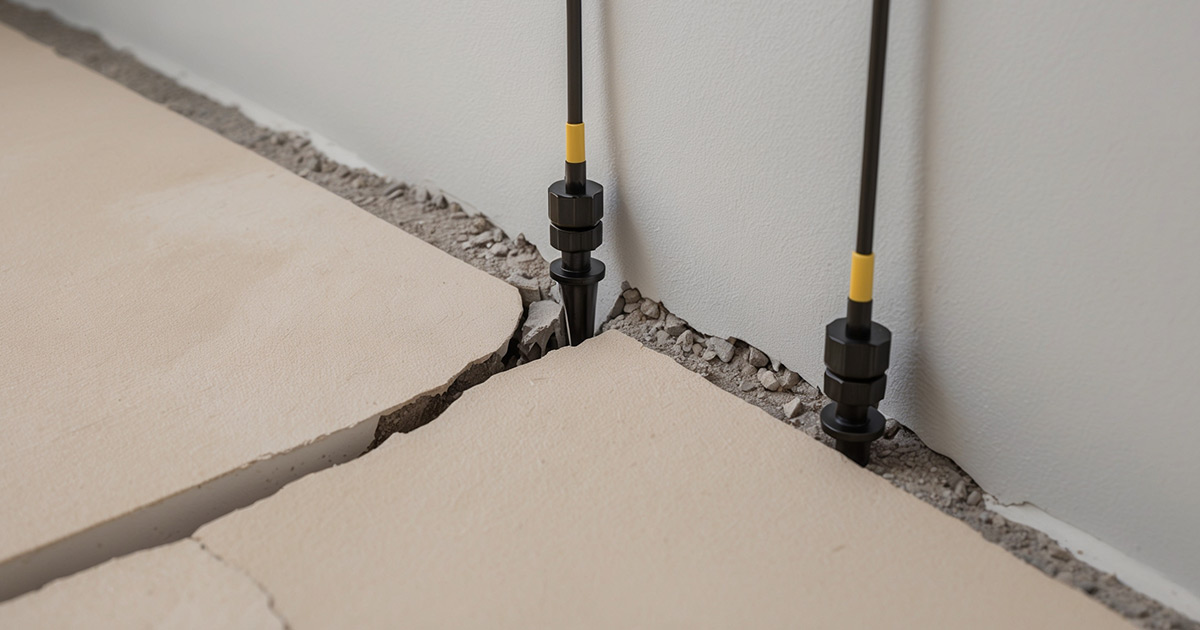Fixing Foundation Cracks
In this guide, Depend Exteriors covers the best way to fix a foundation crack and explains in detail how to fix your foundation crack.
Keep reading to learn all these and more. If you still have questions, call us at 780) 710-3972.
Best Way to Fix Foundation Cracks
The best way to fix foundation cracks, especially those that are structural, is through epoxy injection. This method is widely recognized for its effectiveness in restoring the integrity of concrete structures, as it creates a solid bond that can withstand further stress and prevents water infiltration. Here’s a detailed breakdown of the process:
Why Epoxy Injection is the Best Method
Epoxy injection is suitable for narrow (less than 1/4 inch) cracks that have structural significance. It is particularly effective because it fills the crack completely, bonding with the surrounding concrete to restore the foundation’s structural capacity.
Unlike other methods, epoxy injection can penetrate deeply into cracks, providing a long-lasting solution for maintaining the foundation’s stability.
Step-by-Step Process for Epoxy Injection
- Prepare the Crack and Area:
- Clean the Surface: Remove dirt, loose concrete, or debris using a wire brush or compressed air. This ensures that the epoxy adheres well.
- Install Injection Ports: Drill holes along the crack at intervals (typically 4 to 8 inches apart) and insert injection ports. These ports allow the epoxy to be injected at various points, ensuring even distribution throughout the crack.
- Seal the Crack Surface: Apply an epoxy adhesive or quick-setting sealant between the ports to prevent the injected epoxy from leaking out. This step is crucial for maintaining pressure during the injection process.
- Mix the Epoxy:
- Use a two-part epoxy resin system specifically designed for crack injection. Mix the components according to the manufacturer’s instructions to achieve the correct viscosity and curing properties.
- Inject the Epoxy:
- Start at the lowest injection port for vertical cracks or at one end for horizontal cracks. Inject the epoxy using a pressure gun or injection equipment capable of regulating pressure (usually up to 200 psi). The epoxy should flow until it emerges from the next port, ensuring the crack is filled before moving to the next port.
- Repeat this process along the entire crack, moving systematically from port to port. Monitor for any leaks and reseal areas if necessary.
- Cure and Finish the Repair:
- Allow the epoxy to cure as per the manufacturer’s guidelines, typically overnight. Once cured, remove the injection ports and grind down any excess epoxy to create a smooth surface.
- The foundation can be further treated with a waterproof sealant to prevent moisture penetration if required.
Benefits of Epoxy Injection
- Structural Reinforcement: Epoxy injection restores the foundation’s original strength by bonding the concrete.
- Durability: This method creates a robust, long-lasting repair that can handle significant stress and prevent future movement.
- Waterproofing: Properly applied epoxy prevents water from seeping through the crack, protecting the structure from further damage.
Epoxy injection is the best choice for repairing structural foundation cracks due to its effectiveness and durability. However, to ensure successful results, it’s crucial to follow proper procedures and use professional services for the task.
How Should I Fix Foundation Cracks?
1. Start by Identifying the Type of Foundation Crack and Its Cause
Identify the type of crack to determine the best repair method and assess potential risk.
- Hairline Cracks: These are caused by shrinkage as concrete cures or minor settling of the foundation. These are often non-structural and only compromise structural integrity if they widen over time.
- Vertical Cracks are commonly caused by normal foundation settling. They are usually less severe but still require monitoring. Basic repairs such as epoxy injection can effectively seal these cracks.
- Horizontal or Diagonal Cracks: These are often more concerning and can indicate structural issues such as lateral soil pressure or water-related stress. Horizontal cracks, especially those in the middle of walls, suggest that the soil outside is exerting force on the foundation. Such cracks typically require professional evaluation and reinforcement.
2. Evaluate the Severity of Foundation Cracks
Evaluate the severity of cracks to determine the urgency of repairs and the appropriate method:
- Measure the Crack Width:
- Use a crack gauge or ruler to measure the width of the crack.
- Cracks less than 1/8 inch are generally cosmetic and may only require monitoring.
- Cracks wider than 1/4 inch indicate a potential structural issue and need immediate attention.
- Monitor Crack Expansion:
- Install a monitoring tool such as the Avongard Crack Monitor or a simple pencil-and-tape method. Mark the ends of the crack and measure any movement periodically.
- If the crack expands, it suggests ongoing structural movement, which might require more extensive intervention.
- Inspect the Crack’s Pattern and Location:
- Long cracks stretching over windows, doors, or load-bearing walls could indicate significant stress.
- Check for bulging or displacement around the cracks, which may suggest foundational shifts or soil movement beneath the structure.
3. Prepare the Crack for Effective Repair
Proper preparation of the crack ensures the repair material adheres well and provides a lasting solution:
- Clean the Area Thoroughly:
- Use a wire brush to remove debris, dust, or loose materials inside and around the crack. A clean surface allows the repair compound to adhere better.
- Shape the Crack for Better Adhesion:
- For small to medium cracks, use a chisel to create a V-shape along the crack. This expands the surface area where the repair material can bond, ensuring a stronger seal.
4. Select the Best Repair Method for the Type and Severity of Crack
The best repair method depends on the crack’s characteristics and severity:
- Epoxy Injection:
- It is ideal for narrow structural cracks (up to 1/4 inch). This method restores the foundation’s structural integrity by bonding the crack internally.
- Follow the manufacturer’s guidelines when mixing and injecting the epoxy to ensure it penetrates fully and cures effectively.
- Polyurethane Foam Injection:
- This foam is best for wider or active cracks that may expand or contract. It expands to fill the crack, providing flexibility and water resistance.
- It is particularly suitable for areas where waterproofing is critical.
- Hydraulic Cement:
- Effective for cracks that show signs of leaking. Hydraulic cement expands as it sets, creating a tight seal that blocks water infiltration and strengthens the affected area.
- Apply with a trowel and ensure a smooth finish for uniform sealing.
5. Detailed Steps for the Repair Process Based on Chosen Method
Follow these specific steps to ensure proper application and lasting repair:
- Epoxy/Polyurethane Injection:
- Drill injection ports along the crack at regular intervals, ensuring they align for even distribution.
- Inject the epoxy or foam using a caulking gun or injection kit, applying pressure as per the manufacturer’s instructions. Allow the material to cure fully before removing the ports.
- Hydraulic Cement Application:
- Mix the hydraulic cement according to instructions and fill the crack using a trowel.
- Smooth the surface and allow adequate curing time. For best results, monitor the area for any signs of water infiltration.
6. Implement Effective Waterproofing and Prevention Measures to Avoid Future Cracks
Preventing future foundation cracks involves addressing external factors and ensuring proper water management:
- Apply Exterior Waterproofing Membranes:
- Coat the exterior foundation walls with a waterproof sealant or membrane to prevent moisture infiltration. This is especially important in regions with high water tables or heavy rainfall.
- Maintain Proper Grading and Drainage:
- Ensure that the ground around your home slopes away from the foundation. This prevents water from pooling near the foundation and exerting hydrostatic pressure that can cause cracks.
- Install a French Drain System:
- A French drain can help divert water from the foundation if your property is prone to water buildup. This underground drainage system is designed to collect and direct water flow, reducing pressure on the foundation walls.
- Regular Gutter and Downspout Maintenance:
- Keep gutters and downspouts clear of debris and ensure they direct water at least five feet away from the foundation. This prevents water accumulation at the base of the home, reducing soil expansion and contraction that can lead to cracks.

Depend Exteriors is Edmonton Masonry Foundation Repair Contractor
Depend Exteriors is your trusted masonry foundation repair contractor in Edmonton, Alberta. We specialize in stabilizing and restoring damaged foundations, addressing issues like cracks, bulging walls, and water infiltration.
Our team conducts thorough assessments, utilizing foundation underpinning and masonry reinforcement techniques to ensure the structural stability of both residential and commercial properties. O
ur commitment to using durable materials and proven methods provides long-lasting solutions tailored to Edmonton’s unique climate, safeguarding your property from further damage. For expert foundation repair, contact us at 780-710-3972.
FAQs
What is the best foundation crack repair method?
Epoxy injection is the most effective method for repairing foundation cracks, bonding cracks internally, and restoring structural integrity we use at Depend Exteriors. Polyurethane foam injections are used to seal and prevent water infiltration for non-structural or wider cracks. For exterior issues, combining these methods with waterproofing and drainage solutions is ideal for long-term stability.
Can foundation cracks be repaired?
Foundation cracks can be repaired using epoxy injections for structural reinforcement, polyurethane for waterproofing, and hydraulic cement for smaller or cosmetic cracks. The repair approach depends on the type and severity of the crack.
Is it better to fix foundation cracks from inside or outside?
It depends on the crack type and location. Exterior fixes are often necessary for severe leaks or moisture issues, as they prevent water from entering the foundation. Interior repairs, like epoxy injections, are effective for reinforcing structural integrity. A combination of both methods is sometimes recommended for comprehensive protection.
Is it expensive to fix a cracked foundation?
The cost varies widely. Simple repairs like epoxy injections can be more affordable, while extensive repairs involving excavation and exterior waterproofing can be more expensive. On average, repairs range from CAD 700 to CAD 3,500 for basic interventions, with larger projects exceeding CAD 15,000, depending on the extent of the damage.
Does homeowners insurance cover foundation problems?
Homeowners’ insurance typically does not cover foundation cracks unless they result from a covered event, such as earthquakes or floods (if the policy includes such coverage). Issues from general wear, soil movement, or poor maintenance are generally not covered.
Why do foundation cracks happen?
Foundation cracks can occur due to settling, poor drainage, soil expansion (especially in clay-heavy areas), and concrete shrinkage. Other causes include thermal changes, excess moisture, and construction inadequacies.
How long will a cracked foundation last?
A cracked foundation may last indefinitely if the cracks are minor and stable. However, if the cracks worsen due to ongoing movement or water infiltration, the building’s structural integrity could be compromised over time. Timely intervention is crucial for maintaining long-term durability.
How much does it cost to fix a foundation crack?
The cost of fixing a foundation crack typically ranges from CAD 700 to CAD 3,500 for simple repairs like epoxy injections. More complex repairs involving excavation and waterproofing can cost CAD 15,000 or more, depending on the severity of the damage and the repair method required.



